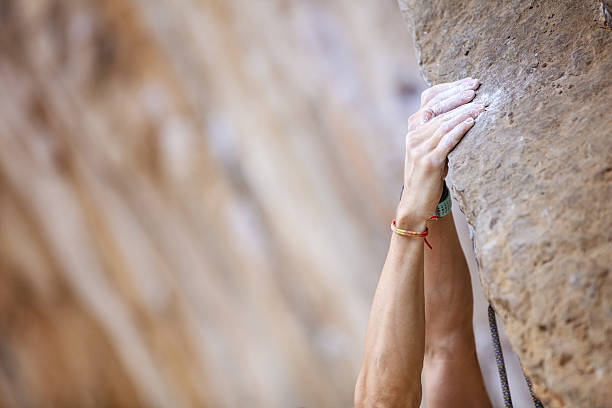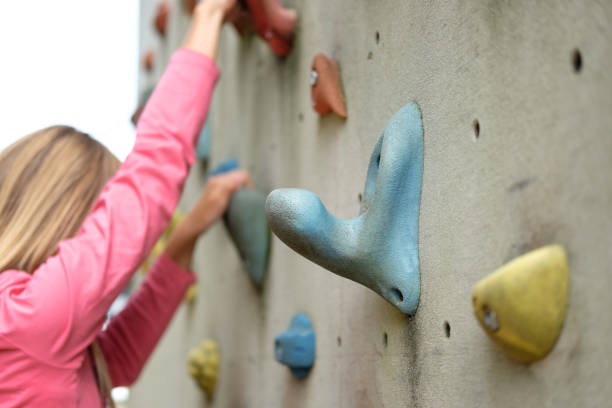Bouldering refers to a distinctive method of rock climbing where individuals climb rock formations or synthetic rock walls, usually about six meters in height, without the support of ropes or harnesses. This climbing technique demands minimal equipment.
Bouldering is a test of climbing skills with most climbers only requiring chalk for their hands and specialist climbing shoes to maintain their grip and no other gear required at all. Some will use a bouldering mat to prevent injury if they were to fall.
Generally, bouldering involves navigating a series of boulders using specific moves and techniques in order to reach the top and complete the actual climb. There are some challenges that require the climber to travel horizontally over the course as well.
You may also like: Guide to 15 of the Best Quickdraws of 2021

Using artificial climbing walls
For climbers who want to try the sport and learn the skills from scratch in a safe environment, then using an artificial climbing wall indoors, can be a perfect choice. It allows the practice of skills, with the added safety of an indoor environment.
In fact, many bouldering competitions even include indoor climbing wall elements as part of the skills test, as well as working across outdoor courses, so it’s good to tune up your skills at a climbing center first.
You may also like: The Best Carabiners of 2021 – Reviews
History of bouldering
Bouldering actually began as a training method for those who were going to be taking part in rope climbs or go mountaineering. It was a way for climbers to tryout out their moves while remaining close to the ground.
However, it soon developed into a discipline of its own, with different levels of difficulty created, bouldering courses springing up naturally around the world, and competitions developing within the sport.
As well as the climbing skills required, bouldering also grew in popularity as a fitness regime thanks to its ability to increase stamina, overall fitness levels, coordination, and also hand and finger strength.

Things to consider when bouldering
Different types of rock offer different types of bouldering challenges but many rocks are used for the sport, including volcanic rock and limestone. Granite can be used but features challenging cracks and slabs. Sandstone boulders are also popular due to their over-hanging features.
Most artificial climbing walls are built using fake rocks, wooden panels and plastic hand holds, often with overhanging surfaces to provide the right challenges for learning and practicing all climbing skills.
Using artificial walls provides great ways to try out skills and learn and practice techniques safely. Some centers now have flat walls as well, to help climbers learn to co-ordinate their movements more effectively.
They are also a great way to practice following certain routes, by using colored tape or holds to indicate particular challenges that would be faced out in a natural bouldering route, so climbers following routes can try them out safely first.
What is highball bouldering?
Another popular form of bouldering is known as highball bouldering, which, as it sounds, involves climbing up tricky, tall boulders. This climbing is a test of skill, strength, and also of clear mental focus.
Generally, for a course to be considered a highball, the boulders need to be higher than 15 feet tall but any higher than around 35 feet and it becomes free climbing rather than bouldering, due to the height.
Highball bouldering is thought to have started in the sixties when a climber named John Gill, climbed a steep face on a granite rock spire.
Environmental issues
One of the problems which have grown up alongside bouldering is the impact that it can have on the environment when it is carried out in a natural outdoor location. Issues associated with the activity include trampled plants and erosion of soil.
Other issues include climbers hiking onto private or protected land areas to take part in bouldering climbs, which has led it to be banned in some places due to the potential long-term damage to vegetation and the environment.
Conclusion
Bouldering is growing in popularity both as a competitive sport and as a fitness routine, thanks to the lack of equipment required and the accessibility for beginners thanks to the growth in indoor artificial climbing centers.
While bouldering out in nature is the ultimate climbing challenge, those who take part need to be aware of the considerable environmental factors which come into play, including the challenges particular rock types pose.
It’s important to take part in any bouldering challenge, responsibly, taking into account the natural habitat around you and any land permissions which might be required to enter particular areas, as well as not going off-trail.
Bouldering is a highly skilled sport in which climbers can show off their strength, balance, and mental focus, at a relatively safe height, without having to shell out for lots of expensive equipment, or learning all of the techniques associated with rope climbing.





